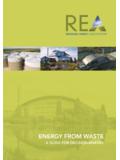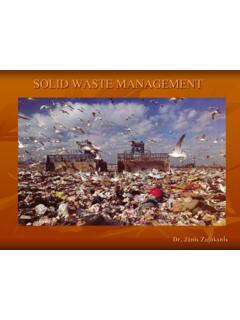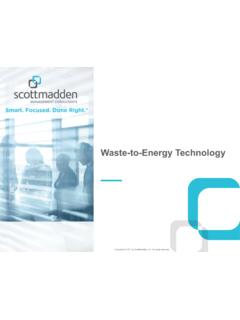Transcription of ENERGY FROM WASTE - Renewable Energy Association
1 ENERGY FROM WASTE . A GUIDE FOR DECISION-MAKERS. What is ENERGY from WASTE ? ENERGY can be recovered from WASTE by various (very different) technologies. It is important that recyclable material is removed first, and that ENERGY is recovered from what remains, from the residual WASTE . This leaflet covers the following ENERGY from WASTE (EfW) technologies: Combustion, in which the residual WASTE is burned at 850 C and the ENERGY recovered as electricity or heat Pyrolysis and gasification, where the fuel is heated with little or no oxygen to produce syngas which can be used to generate ENERGY or as a feedstock for producing methane, chemicals, biofuels, or hydrogen Anaerobic digestion, which uses microorganisms to convert organic WASTE into a methane-rich biogas that can be combusted to generate electricity and heat or converted to biomethane.
2 This technology is most suitable for wet organic wastes or food WASTE . The other output is a biofertiliser. It is also possible to harness ENERGY from WASTE after it has been disposed of in a landfill. As the UK has traditionally landfilled much of its WASTE , we are currently exploiting this legacy at many landfills, by capturing landfill gas produced as WASTE decomposes. Landfill gas contains methane, which is a powerful greenhouse gas. Capturing it prevents it from polluting the atmosphere. The production of landfill gas will slowly decline as we move towards more sustainable and efficient practices of WASTE management, focusing on the technologies described in this guide.
3 Harnessing ENERGY from WASTE has many benefits:- It helps the UK reduce its dependency on ENERGY imports It contributes towards reducing carbon emissions and meeting Renewable ENERGY targets When used for electricity generation, these technologies have a steady and controllable output, sometimes referred to as providing baseload power It has very good sustainability and greenhouse gas saving characteristics, as it makes further use of materials that have already been discarded. This is reflected in the methodology used under the Renewable ENERGY Directive for assessing carbon and sustainability characteristics.
4 About this guide This guide has been produced to: Show how much ENERGY can be recovered from WASTE , after recycling has taken place Illustrate how EfW contributes to the UK's ENERGY needs and Renewable ENERGY targets Give an overview of the various types of technologies used Describe the financial incentives in place to promote deployment of EfW. Show decision-makers what high-level actions need to be taken in order that the UK. can convert more residual WASTE to ENERGY Cover Images LEFT:BiogenGreenfinch's Westwood Anaerobic Digestion plant MIDDLE:SITA UK's ENERGY -from- WASTE facility in Teesside RIGHT: Lakeside EfW Ltd is a joint venture of Viridor and Grundon WASTE Management.
5 Located near Slough, the award-winning design of the building fits and enhances the local landscape. ENERGY FROM WASTE A GUIDE FOR DECISION-MAKERS. These technologies have very different characteristics and it is important to Combustion Gasification & Pyrolysis Combustion plants are often referred simply as EfW Sometimes referred to as ATTs (Advanced Thermal plants. They have a boiler to capture and convert the Treatments), gasification and pyrolysis plants thermally treat released heat into electricity and steam, and extensive air fuels without allowing enough oxygen for complete pollution control systems that clean the combustion combustion.
6 They are typically smaller and more flexible gases to comply with regulatory emission limits before than combustion plants and typically consume between 25. they are released to atmosphere through a chimney. and 150 thousand tonnes of WASTE per year, although some These plant typically use between 50 300 thousand variations can consume up to 350 thousand tonnes per year. tonnes per year of fuel. Typical fuels Typical fuels municipal Solid WASTE (MSW). municipal Solid WASTE (MSW) Commercial & Industrial WASTE (C&I). Commercial & Industrial WASTE (C&I) Refuse derived fuel (RDF) or Solid Recovered Fuel (SRF).
7 Refuse derived fuel (RDF) or Solid Recovered Fuel (SRF) (non- WASTE fuels, wood / other forms of biomass). Outputs Outputs Electricity or Heat or both together if a Combined Electricity or Heat or both together if a Combined Heat and Power Plant (CHP). Heat and Power Plant (CHP). Syngas, which can be purified to produce biomethane , Bottom ash - This is what is left after combustion and biofuels, chemicals, or hydrogen it can be used as an aggregate or road bed material. If metal was not removed pre-combustion, it is Pyrolysis oils these can be used to fuel engines, or recycled at this point. turned into diesel substitute Fly ash - This is the material collected by the pollution Feedstocks for the chemical industry allowing control equipment.
8 Biomass to substitute for oil in the production of plastics for example Bottom ash, Char, or Slag by-products which can be used for beneficial purposes such as aggregates or road bed material (Fly ash produced by some but not all plants). Lakeside EfW Ltd treats 410,000 tonnes of WASTE a year, generating 37 megawatts of electricity and diverting about 95 per cent of inputs from landfill. Advanced Plasma Power's Gasplasma Gasification Plant ENERGY FROM WASTE A GUIDE FOR DECISION-MAKERS. appreciate this. Anaerobic Digestion (AD) / Biogas Gasification and pyrolysis plants, operating or with planning permission Biogas/AD plants operate at low temperature, allowing microorganisms to work on the feedstock, turning it into Operating Biogas projects taking WASTE biogas, which is a mixture of carbon dioxide and methane.
9 Operating ENERGY from WASTE Combustion plants They are typically much smaller than the combustion or gasification plants. A biogas plant is most appropriate for Biomethane Injection wet organic wastes, such as food WASTE , sewage sludge, agricultural residues or ENERGY crops. Typical fuels Food wastes Some forms of industrial and commercial WASTE , abattoir WASTE Agricultural materials and sewage sludge. Outputs Biogas, which can be used to generate electricity and heat CHP is the norm for such plants Biomethane for the gas grid, with the appropriate gas scrubbing and injection technologies Digestate - a material which can be used as a useful fertiliser / soil conditioner on agricultural land in lieu of chemical fertilisers BiogenGreenfinch's Westwood AD plant.
10 Northamptonshire ENERGY from WASTE and the WASTE hierarchy The WASTE hierarchy has been fundamental in designing national Prevention strategies and policies that move the UK away from its dependence Preparing for re-use on landfilling. After minimising the amount of WASTE that is produced in the first place through WASTE Recycling prevention and reuse, the next priority is to recycle as much useful material as possible from Other recovery the WASTE that is unavoidably generated. Respecting the WASTE hierarchy means that ENERGY Disposal is recovered from WASTE after secondary materials have been removed for recycling.

















